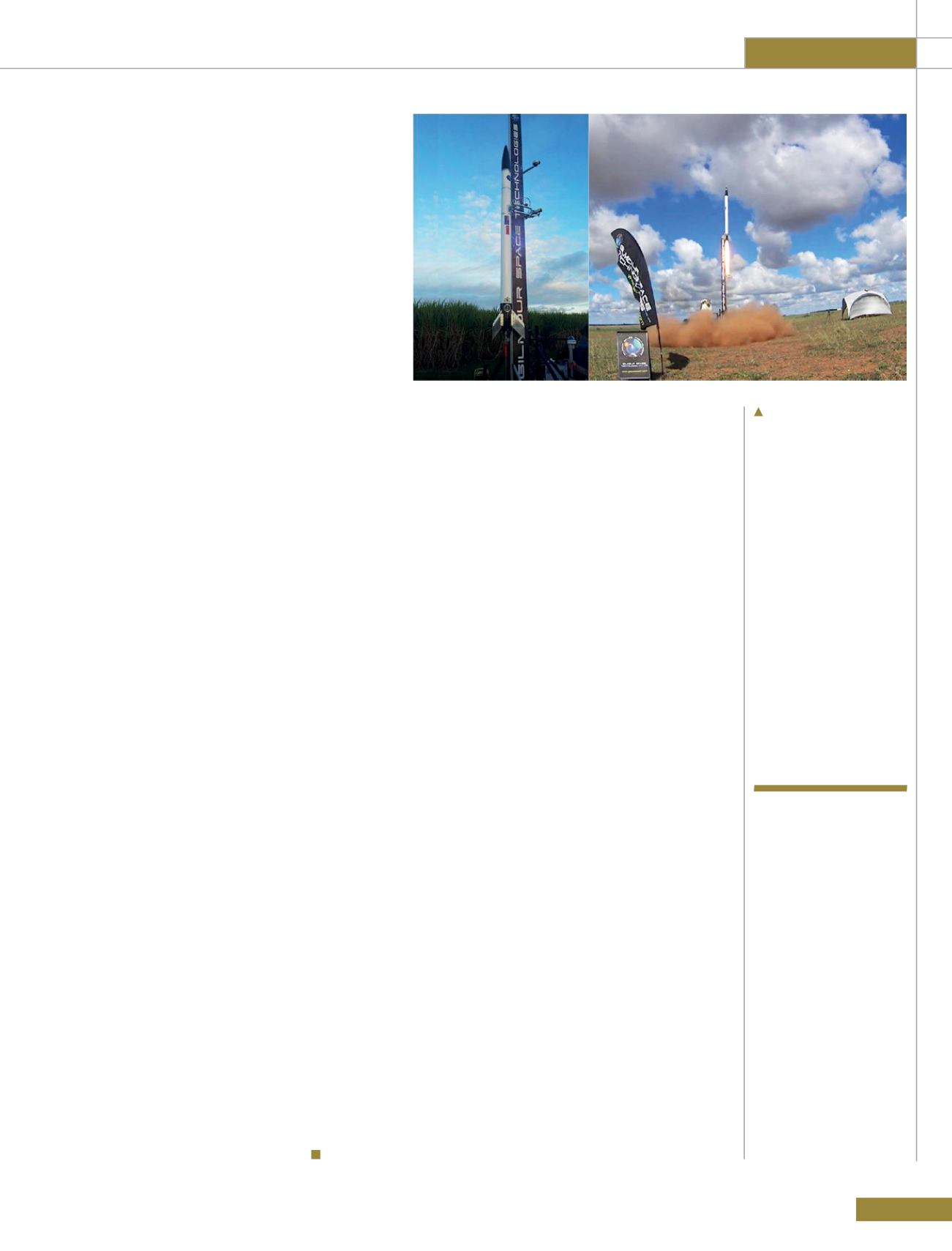
ROOM
97
Opinion
The US military wants to be able to launch small
satellites, at relatively short notice (e.g. several
months), specifically adapted to the needs of a
particular campaign, to supplement and enhance
existing and anticipated capabilities, and the
satellites only need to endure for several years
rather than a couple of decades. Ideally, the US
would want to share the resource burden (and the
benefits) of developing an ORS capability, as well
as recognising the national security benefits of
disaggregating launch facilities.
Australia’s role
Australia not only has the geography, stability
and knowledge to manufacture and launch
small satellites from its own soil but has existing
commercial and research enterprises actively
involved in key areas - Equatorial Launch Australia,
UNSW’s Space Engineering Faculty developing
small satellites, Gilmour Space developing rockets
for launch of small satellites, Defence Science and
Technology Group’s rocket propulsion experts and
the University of Queensland’s rocketry research.
So how does Australia offer a practical pathway for
synergistic cooperation with the United States in
its development of the ORS concept?
Every two years the Australian Defence Force
invites the United States, ‘five-eye’ allies and
others to participate in a large military exercise
- Talisman Sabre. For several weeks, more than
30,000 military personnel from Australia and its
allies amass in northern Queensland to practice
how they would cooperate to initiate, prosecute
and successfully end a military campaign [13].
The Department of Defence could commit to
launch a small satellite, or more than one, every
two years in support of Talisman Sabre and in
cooperation with the US and other allies, and they
could do the same in respect of major exercises in
their own countries. The Department of Defence
could run a competition for local industry to
submit proposals on what to launch and how.
Initially, it may not be possible to do it alone,
but over several iterations of the Talisman Sabre
exercise, Australia could maximise local industry
participation. The Department of Defence could
partner with the Department of Industry, Innovation
and Science to facilitate this.
For a relatively small public investment in a project
in which the costs would be shared, Australia could
realise significant benefits for its national security,
for its allies and its alliances, whilst also providing
a huge boost for the capacity of local industry and
its opportunity to capture a significantly greater
proportion of the global space industry.
About the author
Duncan Blake
transferred from the permanent Air Force to the Reserves
in January 2017 after 22 years as a Legal Officer in the Royal Australian Air
Force. He was legal advisor to the Australian Defence Space Coordinating
Office and chaired inter-departmental and international working
groups in respect of strategic space law. His thesis topic for his Master
of Laws degree at McGill University was on the need for a ‘Manual on
International Law Applicable to Military Uses of Outer Space’ (MILAMOS).
References
1 Adelaide Convention Bureau, Press Release, “Adelaide’s ‘over the
Moon’ with space industry event win” (4 October 2014).
2 Peter Morton, Fire Across the Desert: Woomera and the Anglo-
Australian Joint Project 1946-1980 (Canberra: Australian Department
of Defence, 1989).
3 Australia, Commonwealth, Senate, Standing Committee on Econom-
ics, Lost in Space? Setting a new direction for Australia’s space science
and industry sector (21 November 2008) (Chair: Annette Hurley).
4 Edited Advancing Australia in Space, report for Space Industry As-
sociation of Australia (Canberra: 2017).
5 Anthea Batsakis, “Scientists push for Australian space agency” (22
March 2017) Cosmos Magazine (Melbourne: Cosmos Media, 2017).
6 Quotes are taken from: Department of Industry, Innovation and
Science, Australian Civil Space (webpage accessed on 20 May 2017),
online: <
/
SPACE/Pages/default.aspx >.
7 Department of Industry, Innovation and Science, Reform of the
Space Activities Act 1998 (webpage accessed on 20 May 2017), online:
<
/
Review-of-the-Space-Activities-Act-1998.aspx >.
8 Union of Concerned Scientists, UCS Satellite Database (webpage
accessed on 20 May 2017) <
-
ons_and_global_security/space_weapons/technical_issues/ucs-
satellite-database.html >.
9 Doug Messier, SpaceX Wants to Launch 12,000 Satellites <
.
parabolicarc.com/2017/03/03/spacex-launch-12000-satellites/ >.
10 Phillip Swarts, “Trump’s pick for Air Force secretary has a record of backing
the NRO and ORS” (24 January 2017) Space News (Alexandria, Virginia: 2017).
11 Todd Harrison et al, with the collaboration of Scott Aughenbaugh et
al., edited Implications of Ultra-Low-Cost Access to Space, report for
Center for Strategic & International Studies (Washington DC: Rowman &
Littlefield, 2017).
12 This idea is discussed in detail in Office of the Assistant Secretary of
Defense for Homeland Defense and Global Security, Space Domain
Mission Assurance: A Resilience Taxonomy, White Paper (September
2015). That paper uses terms like ‘disaggregation’ in a very specific way. I
use the word more broadly to cover much of what the paper refers to as
‘resilience’.
13 Department of Defence, Exercise Talisman Sabre 2017 (webpage
accessed on 20 May 2017), online: <
/
Exercises/TS17/ >.
In June 2016 Gilmour
Space successfully
launched a test rocket at
Westmar, about 400 km
west (inland) of Brisbane
in Australia - the first
privately developed hybrid
sounding rocket designed,
built and launched by an
Australian (and
Singaporean) company. It
was also the first
successful hybrid rocket
test launch using 3D
printed rocket fuel. The
company is developing a
three-stage rocket
capable of launching up to
380 kg into low Earth
orbit.
Demand
for satellite
services often
outstrips
supply and
this problem is
exacerbated by
an exponential
growth in
networked
capabilities
and insatiable
demand for
bandwidth


